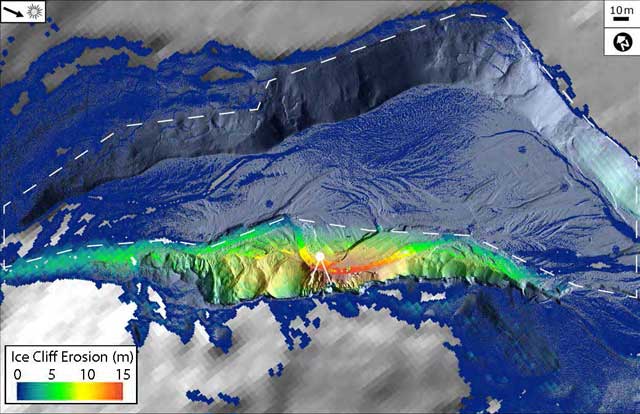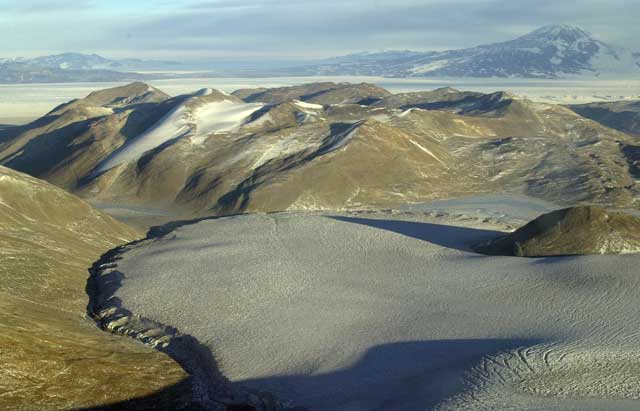|
Seeing the lightRapid permafrost melting in Dry Valleys due to increased solar radiationPosted July 26, 2013
Researchers have documented the first signs of significant permafrost melt in Antarctica from a small valley where an exposed cliff face contains ice from the last ice age. The melt rates are comparable to the Arctic, according to a paper published this month in the journal Nature Scientific Reports. Researchers documented the rapid retreat of ground ice in Garwood Valley, the most southerly in theMcMurdo Dry Valleys “The big tell here is that the ice is vanishing – it’s melting faster each time we measure,” said Joseph Levy After Levy and colleagues noted visible effects of ground ice retreat in Garwood Valley, they began to monitor the valley, combining time-lapse photography and weather-station data at 15-minute intervals to create a detailed view of the conditions under which the ice is being lost. Ice once filled Garwood and the other valleys during the Last Glacial Maximumabout 18,000 years ago when large ice sheets extended across both the northern and southern hemispheres. In Antarctica, the West Antarctic Ice Sheet spread across the Ross Sea, where the world’s largest ice shelf remains today. It also spilled into the Dry Valleys across McMurdo Sound. In Garwood, a relatively shallow valley, the West Antarctic Ice Sheet pushed its way uphill, eventually damming a river that flows from a glacier at the other end of the valley. The river melted out a small lake into the ice, dumping an enormous amount of sediment to create a huge delta. Sediment along the walls of the valley also buried the intrusive ice. Eventually, as the ice age, known formally as a glacial period, waned and the ice melted back, the lake poured out of the Garwood Valley, like a plug pulled out of a sink drain. However, a large section of that ice, which is thousands of years old, remained buried under sediments and rock. [See previous article — Valley of buried ice: Garwood reveals layers of climate history from Last Glacial Maximum.] Rising temperatures do not account for the increased melting of the buried ice in present-day Garwood Valley, according to the authors. The Dry Valleys overall experienced a well-documented cooling trend from 1986 to 2000, followed by stabilized temperatures to the present, they said. Rather, Levy and his co-authors attribute the melting to an increase in radiation from sunlight stemming from changes in weather patterns, which have resulted in an increase in the amount of sunlight reaching the ground. As the ground ice melts, the frozen landscape sinks and buckles, creating what scientists describe as “retrogressive thaw slumps.” Acceleration in the prevalence of such slumps has been well documented in the Arctic and other permafrost regions, but not in Antarctica. If Antarctica warms as predicted during the coming century, the melting and slumping could become more dramatic as warmer air temperatures combine with sunlight-driven melting to thaw ground ice even more quickly, according to Levy. The thawing of frozen soil in the Arctic had drawn plenty of attention in recent years over concerns ranging from the release of powerful greenhouse gases into the atmosphere to the destruction of infrastructure like roads and buildings as the ground slumps away. Less research has occurred in the Antarctic. However, aside from the work by Levy and colleagues, an international effort is under way to learn more about the characteristics of Antarctic permafrost and its sensitivity to climate change. The program is called PERMANTAR While ground ice is not a major component of Antarctica’s vast reserves of frozen water like it is in the Arctic, there are major expanses of ground ice in the Dry Valleys, the Antarctic Peninsula and the continent's ice-free islands. Garwood Valley could tell the story of what will happen in these “coastal thaw zones,” Levy noted. “There's a lot of buried ice in these low-elevation coastal regions, and it is primed to melt,” he said. NSF-funded research in this article: Joseph Levy, Oregon State University, Award Nos. 1212307 and 1043785 |



For USAP Participants |
For The Public |
For Researchers and EducatorsContact UsU.S. National Science FoundationOffice of Polar Programs Geosciences Directorate 2415 Eisenhower Avenue, Suite W7100 Alexandria, VA 22314 Sign up for the NSF Office of Polar Programs newsletter and events. Feedback Form |





